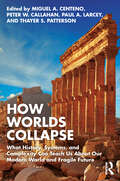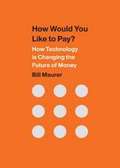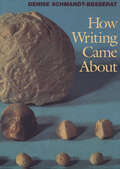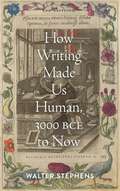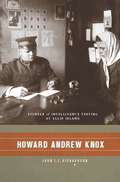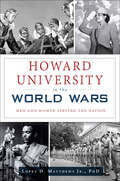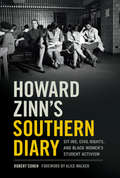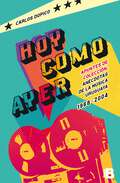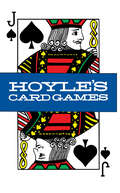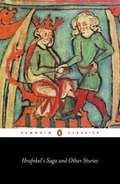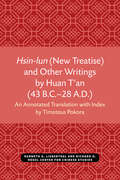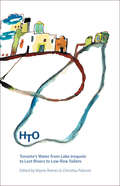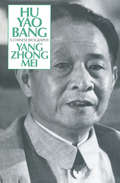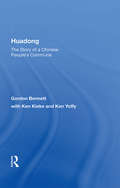- Table View
- List View
How Women Decide: What's True, What's Not, And Why It Matters
by Therese Huston&“An authoritative guide to help women navigate the workplace and their everyday life with greater success and impact&” (Forbes). So, you&’ve earned a seat at the table. What happens next? We all face hard decisions every day—and the choices we make, and how others perceive them, can be life changing. There are countless books on how to make those tough calls, but How Women Decide is the first to examine a much overlooked truth: Men and women reach verdicts differently, and often in surprising ways. Stress? It makes women more focused. Confidence? Caution can lead to stronger resolutions. And despite popular misconceptions, women are just as decisive as men—though they may pay for it. Pulling from the latest science on decision-making, as well as lively stories of real women and their experiences, cognitive scientist Therese Huston teaches us how we can better shape our habits, perceptions, and strategies, not just to make the most of our own opportunities, but to reform the culture and bring out the best results—regardless of who&’s behind them.
How Women Got Their Curves and Other Just-So Stories: Evolutionary Enigmas
by David Barash Judith Eve LiptonSo how did women get their curves? Why do they have breasts, while other mammals only develop breast tissue while lactating, and why do women menstruate, when virtually no other beings do so? What are the reasons for female orgasm? Why are human females kept in the dark about their own time of ovulation and maximum fertility, and why are they the only animals to experience menopause?David P. Barash and Judith Eve Lipton, coauthors of acclaimed books on human sexuality and gender, discuss the theories scientists have advanced to explain these evolutionary enigmas (sometimes called "Just-So stories" by their detractors) and present hypotheses of their own. Some scientific theories are based on legitimate empirical data, while others are pure speculation. Barash and Lipton distinguish between what is solid and what remains uncertain, skillfully incorporating their expert knowledge of biology, psychology, animal behavior, anthropology, and human sexuality into their entertaining critiques. Inviting readers to examine the evidence and draw their own conclusions, Barash and Lipton tell an evolutionary suspense story that captures the excitement and thrill of true scientific detection.
How Women Got Their Curves and Other Just-So Stories: Evolutionary Enigmas
by David P Barash Judith Eve LiptonThe authors of Gender Gap: The Biology of Male-Female Differences take readers on &“a joyride of intellectual discovery . . . full of provocative ideas&” (Pepper Schwartz, author of Prime). So how did women get their curves? Why do they have breasts, while other mammals only develop breast tissue while lactating, and why do women menstruate, when virtually no other beings do so? What are the reasons for female orgasm? Why are human females kept in the dark about their own time of ovulation and maximum fertility, and why are they the only animals to experience menopause? David P. Barash and Judith Eve Lipton, coauthors of acclaimed books on human sexuality and gender, discuss the theories scientists have advanced to explain these evolutionary enigmas (sometimes called &“Just-So stories&” by their detractors) and present hypotheses of their own. Some scientific theories are based on legitimate empirical data, while others are pure speculation. Barash and Lipton distinguish between what is solid and what remains uncertain, skillfully incorporating their expert knowledge of biology, psychology, animal behavior, anthropology, and human sexuality into their entertaining critiques. Inviting readers to examine the evidence and draw their own conclusions, Barash and Lipton tell an evolutionary suspense story that captures the excitement and thrill of true scientific detection. &“A delightful, thought-provoking volume on perennial questions about female biology . . . Along the way, they present a large amount of accessible information about biology, psychology, physiology and anatomy. Even more important, they demonstrate how scientists work to create and assess hypotheses while having a great deal of fun.&”—Publishers Weekly
How Worlds Collapse: What History, Systems, and Complexity Can Teach Us About Our Modern World and Fragile Future
by Miguel A. Centeno, Peter W. Callahan, Paul A. Larcey, Thayer S. PattersonAs our society confronts the impacts of globalization and global systemic risks—such as financial contagion, climate change, and epidemics—what can studies of the past tell us about our present and future? How Worlds Collapse offers case studies of societies that either collapsed or overcame cataclysmic adversity. The authors in this volume find commonalities between past civilizations and our current society, tracing patterns, strategies, and early warning signs that can inform decision-making today. While today’s world presents unique challenges, many mechanisms, dynamics, and fundamental challenges to the foundations of civilization have been consistent throughout history—highlighting essential lessons for the future.
How Would You Like to Pay?: How Technology Is Changing the Future of Money
by Bill MaurerFrom Bitcoin to Apple Pay, big changes seem to be afoot in the world of money. Yet the use of coins and paper bills has persisted for 3,000 years. In How Would You Like to Pay?, leading anthropologist Bill Maurer narrates money's history, considers its role in everyday life, and discusses the implications of how new technologies are changing how we pay. These changes are especially important in the developing world, where people who lack access to banks are using cell phones in creative ways to send and save money. To truly understand money, Maurer explains, is to understand and appreciate the complex infrastructures and social relationships it relies on. Engaging and straightforward, How Would You Like to Pay? rethinks something so familiar and fundamental in new and exciting ways. Ultimately, considering how we would like to pay gives insights into determining how we would like to live.
How Would You Rule?: Legal Puzzles, Brainteasers, and Dilemmas from the Law's Strangest Cases
by Daniel W. ParkHow Would You Rule is a lighthearted introduction to fundamental concepts of law through strange but true legal cases. Each chapter tells the story of a different case and presents the main arguments of the opposing parties. The twist? Before the ruling of the court is revealed, readers are challenged to put themselves in the shoes--or the robes--of the judges and decide for themselves how they would rule in these cases. After coming up with their own solutions, readers can learn how the actual judges resolved the disputes. The goal is to get readers to think for themselves about what's right and what's wrong, sharpening their own instincts for the reasons and analyses that win arguments.
How Writing Came About
by Denise Schmandt-BesseratIn 1992, the University of Texas Press published Before Writing, Volume I: From Counting to Cuneiform and Before Writing, Volume II: A Catalog of Near Eastern Tokens. In these two volumes, Denise Schmandt-Besserat set forth her groundbreaking theory that the cuneiform script invented in the Near East in the late fourth millennium B. C. -the world's oldest known system of writing-derived from an archaic counting device. How Writing Came About draws material from both volumes to present Schmandt-Besserat's theory for a wide public and classroom audience. Based on the analysis and interpretation of a selection of 8,000 tokens or counters from 116 sites in Iran, Iraq, the Levant, and Turkey, it documents the immediate precursor of the cuneiform script.
How Writing Came About
by Denise Schmandt-BesseratAn &“utterly lucid, thoughtfully illustrated, and thoroughly convincing&” book on the origins of the world&’s oldest known system of writing (American Journal of Archaeology). One of American Scientist&’s Top 100 Books on Science, 2001 In 1992, the University of Texas Press published Before Writing, Volume I: From Counting to Cuneiform and Before Writing, Volume II: A Catalog of Near Eastern Tokens. In these two volumes, Denise Schmandt-Besserat set forth her groundbreaking theory that the cuneiform script invented in the Near East in the late fourth millennium B.C.—the world's oldest known system of writing—derived from an archaic counting device. How Writing Came About draws material from both volumes of this scholarly work to present Schmandt-Besserat&’s theory in an abridged version for a wide public and classroom audience. Based on the analysis and interpretation of a selection of 8,000 tokens or counters from 116 sites in Iran, Iraq, the Levant, and Turkey, it documents the immediate precursor of the cuneiform script.
How You Get Famous: Ten Years of Drag Madness in Brooklyn
by Nicole PasulkaA madcap adventure through a tight-knit world of drag performers making art and mayhem in the greatest city on earth.Ten years ago, an aimless coat check girl better known today as Merrie Cherry sweet-talked her boss into giving her $100 to host a drag show at a Brooklyn dive bar. Soon, kids like Aja were kicking their way into the scene, sneaking into clubs, pocketing their tips to help mom pay the mortgage, and sharing the stage with electric performers like Thorgy Thor and Sasha Velour. Because suddenly, in the biggest, brightest city in America, drag was offering young, broke, creative queer people a chance at real money—and for thousands or even millions of people to learn their names. In How You Get Famous, journalist Nicole Pasulka joyfully documents the rebirth of the New York drag scene, following a group of iconoclastic performers with undeniable charisma, talent, and a hell of a lot to prove. The result is a sweeping portrait of the 21st-century search for celebrity and community, as well as a chronicle of all the struggles, fights, and disappointments along the way. A rollicking account of the quest to make a living through an art form on the cusp of becoming a cultural phenomenon, How You Get Famous offers an unmissable romp through the gritty and glamorous world of Brooklyn drag.
Howard Andrew Knox
by John T. E. RichardsonHoward Andrew Knox (1885-1949) served as assistant surgeon at Ellis Island during the 1910s, administering a range of verbal and nonverbal tests for the mental capacity of potential immigrants. An early proponent of nonverbal intelligence testing (largely through the use of formboards and picture puzzles), Knox developed an evaluative approach that informs the techniques of practitioners and researchers today. Whether adapted to measure intelligence and performance in children, military recruits, neurological and psychiatric patients, or the average job applicant, Knox's pioneering methods deserve in-depth investigation that situates his discoveries within contemporary psychological practice. Completing the first biography of this unjustly overlooked figure, John T. E. Richardson, former president of the International Society for the History of the Neurosciences, takes stock of Knox's understanding of intelligence and his legacy beyond Ellis Island. Consulting published and unpublished sources, Richardson establishes a chronology of Knox's life, including details of his medical training and his time as a physician with the U. S. Army. He describes the conditions that gave rise to intelligence testing, including public concern that the mentally unfit were allowed to settle within the country. He then recounts the development of intelligence tests by Knox and his colleagues and the publication of their research, which captured the attention of a nation. These publications present a useful and extremely human portrait of psychological testing and its limits, particularly regarding the predicament of the people who were examined at Ellis Island. Richardson concludes with the continuation of Knox's work and its changing application in conjunction with modern psychological theory.
Howard Cruse (Biographix #1)
by Janine UtellHoward Cruse tells the life story of one of the most important figures in LGBTQ+ comics. A preacher’s kid from Alabama who became “the godfather of queer comics,” Cruse (1944–2019) was a groundbreaking underground cartoonist, a wicked satirist, an LGBTQ+ activist, and a mentor to a vast network of queer comics artists. His comic strip Wendel, published in The Advocate throughout the 1980s, is considered a revolutionary moment in the development of LGBTQ+ comics, as is his inaugurating the editorship of Gay Comix with Kitchen Sink Press in 1979, which furthered the careers of important artists like Jennifer Camper and Alison Bechdel. Cruse’s graphic novel Stuck Rubber Baby, published in 1995, fictionalizes his own coming out in the context of the civil rights movement in 1960s Birmingham and was a significant forerunner to contemporary graphic novels and memoirs. Howard Cruse draws on extensive archival research and interviews and covers Cruse’s entire body of work: the cute and zany Barefootz, the unexpected innovations of the Gay Comix stories, the domestic intimacies of Wendel, and the complexity and power of Stuck Rubber Baby. The book places Cruse’s art in the context of his life and his times, including the historic movements for gay rights and against the AIDS crisis, and it celebrates this extraordinary and essential figure of LGBTQ+ comics and American comics art more broadly.
Howard S. Becker: Sociology and Music in the Chicago School
by Jean PeneffWho is Howard S. Becker? This book traces his career, examining his work and contributions to the field of sociology. Themes covered include Becker’s theoretical conceptualizations, approaches, teaching style, and positioning in the intellectual milieu. Translated from French by sociologist Robert Dingwall, the English edition benefits from an editorial introduction and additional referencing, as well as a new foreword by Becker himself.
Howard University in the World Wars: Men and Women Serving the Nation (Military)
by Ph.D. Lopez D. Matthews Jr.Despite African Americans' lack of political, social and economic equality in the United States, the students of Howard University answered the call to service in both world wars. Howard supported its men and women in the quest to serve their nation. The university started an army training program during the First World War, and Howard faculty, staff and students pushed the War Department to begin an officer training school for African Americans. The university organized a Reserve Officer Training program in the interwar years, the first at an HBCU. Many of the famed Tuskegee Airmen of World War II were trained first at Howard. Based on a collection of letters sent by Howard students and alumni to the university, historian and archivist Lopez D. Matthews illuminates their wartime experiences.
Howard Zinn's Southern Diary: Sit-ins, Civil Rights, and Black Women's Student Activism
by Robert CohenThe activist and author of A People&’s History of the United States records an in-depth and personal account of the Civil Rights Movement in Atlanta. During the Civil Rights Movement of the 1960s, students of Spelman College, a black liberal arts college for women, were drawn into the historic protests occurring across Atlanta. At the time, Howard Zinn was a history professor at Spelman and served as an adviser to the Student Nonviolent Coordinating Committee. Zinn mentored many of Spelman&’s students fighting for civil rights at the time, including Alice Walker and Marian Wright Edelman. Zinn&’s involvement with the Atlanta student movement and his closeness to Spelman&’s leading activists gave him an insider&’s view of the political and intellectual world of Spelman, Atlanta University, and the SNCC. He recorded his many insights and observations of the time in his Spelman College diary. Robert Cohen presents Zinn&’s diary in full along with a thorough historical overview and helpful contextual notes. It is a fascinating historical document of the free speech, academic freedom, and student rights battles that rocked Spelman and led to Zinn&’s dismissal from the college in 1963 for supporting the student movement.
However Long the Night: Molly Melching's Journey to Help Millions of African Women and Girls Triumph
by Aimee MolloyIn However Long the Night, Aimee Molloy tells the unlikely and inspiring story of Molly Melching, an American woman whose experience as an exchange student in Senegal led her to found Tostan and dedicate almost four decades of her life to the girls and women of Africa.This moving biography details Melching's beginnings at the University of Dakar and follows her journey of 40 years in Africa, where she became a social entrepreneur and one of humanity's strongest voices for the rights of girls and women.Inspirational and beautifully written, However Long the Night: Molly Melching's Journey to Help Millions of African Women and Girls Triumph is a passionate entreaty for all global citizens. This book is published in partnership with the Skoll Foundation, dedicated to accelerating innovations from organizations like Tostan that address the world's most pressing problems.
Hoy como ayer: Apuntes de colección. Anécdotas de la música uruguaya 1968-2004
by Carlos DopicoCarlos Dopico nos propone un viaje emotivo por las canciones y los artistas que son parte de la historia de los uruguayos. Un regreso a la banda sonora de nuestras vidas. La música uruguaya es reconocida por su calidad en todo el mundo. Artistas originales, discos emblemáticos, canciones que se han convertido en himnos, forman parte de un valioso acervo cultural que ha aportado a la construcción de nuestra identidad. Durante muchos años, Carlos Dopico fue un activo partícipe y testigo de la movida musical del Uruguay, dejando testimonio de las luces y sombras de un medio artístico repleto de talento y creatividad, pero sometido a los rigores de un mercado pequeño y con pocos recursos. En este libro se dan cita relatos, anécdotas, testimonios y reflexiones en primera persona que pintan una época. Es un viaje a través de los secretos de las canciones que nos marcaron. Rock, punk, reggae, pop, hip-hop, blues, canción urbana, y otros géneros desfilan por estas páginas, haciéndonos revivir la emoción de la música. Hoy como ayer, la nostalgia y la emoción se traslucen en la escritura certera y reflexiva de Dopico, y en la palabra de los autores de la banda sonora de nuestras vidas.
Hoyles Card Games
by Lawrence H. DawsonFirst published in 1979. Routledge is an imprint of Taylor & Francis, an informa company.
Hrafnkel's Saga and Other Icelandic Stories
by Hermann PalssonTHE stories in this volume date from the thirteenth century, the Golden Age of saga writing,
Hsin-lun (Michigan Monographs In Chinese Studies #20)
by Timoteus PokoraBetter known in his own times than later, Huan T’an (43 BCE–25 CE) was a scholar-official, independent in his thought and unafraid to criticize orthodox currents of his time. A practitioner of the Old Text exegesis of the Classics, he maintained a position on the court during a turbulent time of political crises, uprisings, and civil war, spanning the reigns of four emperors. His principal work, Hsin-lun, differs from other books on political criticism in that it does not deal primarily with history but takes many examples from contemporary social and political life. While belonging to the Old Text group of court officials and scholars, Huan T’an differed radically from them in his stress on direct knowledge, in his range of practical experience, and in his outspoken criticism of popular opinions. He was not a systematic philosopher, but his ideas were influential in the return to a more worldly conception of Confucianism. To translate Huan T’an’s writings, one must reconstruct the texts. Timoteus Pokora uses two nineteenth-century fragments as a basis around which to orient quotations from Hsin-lun from sixty-four other sources, primarily encyclopedias and commentaries. Pokora provides notes to give context to these short references and to account for discrepancies between quotations and originals, and he includes a large index to add coherence and points of entry.
HTO: Toronto's Water from Lake Iroquois to Lost Rivers and Low-flow Toilets (uTOpia)
by Wayne Reeves Christina PalassioDrained by a half-dozen major watersheds, cut by a network of deep ravines and fronting on a Great Lake, Toronto is dominated by water. Like most cities, though, Toronto has mismanaged its water, from the decades-long transformation of the citys creeks into sewersheds to the alteration of Torontos waterfront. Recently, the trend of fettering Torontos water and putting it underground has been countered by persistent citizen-led efforts to recall and restore the citys surface water. In HTO: Toronto's Water From Lake Iroquois to Lost Rivers to Low-flow Toilets, 30 contributors examine the ever-changing interplay between nature and culture, and call into question the citys past, present and future engagement with water.
Hu Yao-Bang: A Chinese Biography
by Zhongmei YangCompares IT parks within the Asian Pacific in search of strategies that policy makers can adopt to: reduce the global digital divide; advance distributional equity; and soften some of the negative effects of economic globalization. "Best practices" are suggested based on these cases.
Huadong: The Story Of A Chinese People's Commune (Westview's Special Studies On China And East Asia)
by Gordon BennettThis concise report on one commune in China's innovative commune system is designed to present key features of the system as a whole. It focuses on the concept of the commune in Chinese Communist Party policy and covers Huadong's government and politics, economy, society, and culture.
The Huainanzi: A Guide to the Theory and Practice of Government in Early Han China
by Sarah A. Queen Andrew Seth Meyer Harold D. Roth John S. Major An LiuCompiled by scholars at the court of Liu An, king of Huainan, in the second century B.C.E, The Huainanzi is a tightly organized, sophisticated articulation of Western Han philosophy and statecraft. Outlining "all that a modern monarch needs to know," the text emphasizes rigorous self-cultivation and mental discipline, brilliantly synthesizing for readers past and present the full spectrum of early Chinese thought. The Huainanzi locates the key to successful rule in a balance of broad knowledge, diligent application, and the penetrating wisdom of a sage. It is a unique and creative synthesis of Daoist classics, such as the Laozi and the Zhuangzi; works associated with the Confucian tradition, such as the Changes, the Odes, and the Documents; and a wide range of other foundational philosophical and literary texts from the Mozi to the Hanfeizi. The product of twelve years of scholarship, this remarkable translation preserves The Huainanzi's special rhetorical features, such as parallel prose and verse, and showcases a compositional technique that conveys the work's powerful philosophical appeal. This path-breaking volume will have a transformative impact on the field of early Chinese intellectual history and will be of great interest to scholars and students alike.
The Huawei Model: The Rise of China's Technology Giant (The Geopolitics of Information)
by Yun WenIn 2019, the United States' trade war with China expanded to blacklist the Chinese tech titan Huawei Technologies Co. Ltd. The resulting attention showed the information and communications technology (ICT) firm entwined with China's political-economic transformation. But the question remained: why does Huawei matter? Yun Wen uses the Huawei story as a microcosm to understand China's evolving digital economy and the global rise of the nation's corporate power. Rejecting the idea of the transnational corporation as a static institution, she explains Huawei's formation and restructuring as a historical process replete with contradictions and complex consequences. She places Huawei within the international political economic framework to capture the dynamics of power structure and social relations underlying corporate China's globalization. As she explores the contradictions of Huawei's development, she also shows the ICT firm's complicated interactions with other political-economic forces. Comprehensive and timely, The Huawei Model offers an essential analysis of China's dynamic development of digital economy and the global technology powerhouse at its core.


